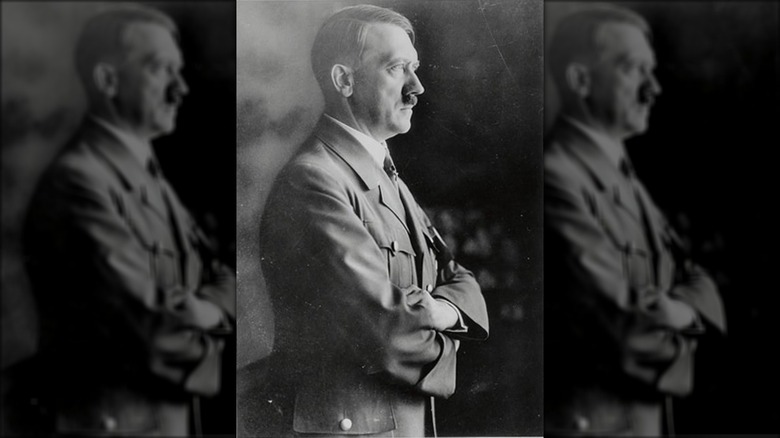The Strange Hitler Conspiracy Theory That Would Change Everything
In 2011, British authors Gerrald Williams and Simon Dunstan published a book offering an alternate version of World War II's final days, which would, if true, change the world's understanding of 20th-century history. "Grey Wolf: The Escape of Adolf Hitler" makes an explosive claim about Adolf Hitler, the leader of the German National Socialist (Nazi) Party, whose so-called Third Reich invaded much of Europe to begin World War II and masterminded the systematic extermination of millions in the Holocaust. According to the pair, he didn't die at the end of the war, as historians generally believe. Instead, Williams and Dunstan argue that the Nazi führer faked his death and escaped during the Battle of Berlin. They say that Hitler fled by U-boat and emigrated to Argentina, where — though he no longer had the absurd wealth he enjoyed in Nazi Germany — he lived out the rest of his days in relative comfort.
If true, it would mean that Hitler, one of the most evil and reviled figures in world history, managed to escape justice and never face the consequences for the violence he brought into the world. It would also suggest that even the Allied powers were willing to push a false narrative to present their victory in World War II as absolute. Here are the details of why some people believe Hitler may have lived in South America long after World War II, and what mainstream historians have to say about the theory.
An escape route to South America
The first question concerning the conspiracy theory put forward in "Grey Wolf" is: Why Argentina? Unless you are familiar with German history before the 20th century, it may appear that the country was chosen at random — a far-flung region where a runaway Nazi might hope to avoid capture by the Allied Forces seeking to bring them to justice. But the truth is that German links to South America went back far longer than that. As a 1946 article in The Atlantic notes, the continent had long been a focus of attention for the German imperialists, who made several colonies there throughout the 19th century. Even today, Argentina has a sizeable minority population of German immigrants, and at the end of World War II, Nazis may have hoped to hide among them without arousing suspicion.
Indeed, thousands of prominent Nazis were confirmed as having made the voyage to South America after the Third Reich crumbled, among them the SS Lieutenant Colonel Adolf Eichmann, senior Auschwitz doctor Josef Mengele, and SS Colonel Walter Rauff. While many figures were eventually captured, others lived to a ripe old age without ever facing justice for their crimes. It is no wonder then that conspiracy theorists and others concerned with the details of the final days of the war have questioned whether the true story of Hitler's demise is credible — or if something else happened entirely.
What conspiracy theorists believe
The accepted narrative concerning the death of Nazi leader Adolf Hitler was well-established shortly after the end of World War II. Investigators interviewed several witnesses who were with Hitler in the Führerbunker under the ruined Reich Chancellery as Soviet forces closed in on them during the Battle of Berlin. These witnesses said Hitler, who grew despondent as his regime collapsed, died by suicide along with his wife, Eva Braun, whom he had married just the day before. After Hitler's death, his body and that of Braun were taken outside and burned with gasoline. While several of Hitler's former allies fled to escape Soviet capture, Hitler loyalist Josef Goebbels also died by suicide along with his family. Soviet troops later had difficulty recovering Hitler's remains, but eventually found fragments of jawbone and cranium that they claimed belonged to the Nazi leader.
But conspiracy theorists deny that the official story is true. Instead, some say that Hitler and Braun survived the Battle of Berlin and managed to escape the city unharmed. They were allegedly smuggled to Argentina where they took a home in Patagonia, lived like normal German immigrants, and even had two daughters together. More intriguingly, it has been claimed that American intelligence services even turned a blind eye to Hiter's escape in exchange for technology developed during the Nazi era. Sources including "Grey Wolf" claim that he actually died in 1962 at the age of 73.
Possible disinformation
Fears that Adolf Hitler may have escaped death in the final days of World War II are nothing new. In fact, such theories go right back to the final year of the war, 1945, when information among the Allies was already strained by the chaos of the final push to the center of Berlin. Such stories were compounded by supposed sightings of Hitler, including one in the 1950s detailed in a declassified CIA report. The document claimed the agency had received correspondence from a former SS officer based in South America, with a photograph of the man in question alongside another figure who bears a striking resemblance to the former Nazi führer. The resemblance was ultimately never investigated due to a lack of resources.
Still, researchers have been keen to note that at the end of World War II the Soviet Union was already thinking ahead to the aftermath of the conflict and how the dice would fall between the Allies. Though they claimed the discovery of Hitler's remains, Joseph Stalin himself publicly expressed his belief that Hitler may have escaped. It is believed that such statements may have been deliberate disinformation to sow doubt between the U.S. and the U.K., and to refocus the Allies' attention on fascists in Spain and Argentina rather than the Soviet Union.
Historians' rebuttal
Despite the growing number of people who have come around to the idea that Adolf Hitler may not have died by suicide in the Führerbunker as history says, experts in the field of European history maintain the consensus that the official story is the correct one. Upon its release, "Grey Wolf" and its accompanying documentary were met with a wave of criticism from academics, who derided its content as nothing more than a fringe theory, citing a lack of evidence. Per The Guardian, noted historian Guy Walters described the theory as "2,000% rubbish," adding: "It's an absolute disgrace. There's no substance to it at all. It appeals to the deluded fantasies of conspiracy theorists and has no place whatsoever in historical research."
And the fact is that there is now even more strong evidence to the contrary. In 2018, a team of analysts examined the jawbone — which contained teeth — that the Soviet Union claimed belonged to Hitler back in 1945. The results were published in the European Journal of Internal Medicine and found the teeth consistent with his vegetarian diet and use of dentures and noted they matched his dental records. The far-fetched conspiracy theory that he escaped to Argentina, it seems, has been utterly debunked, but in the age of the internet, whether that means the story will eventually die out remains to be seen.




